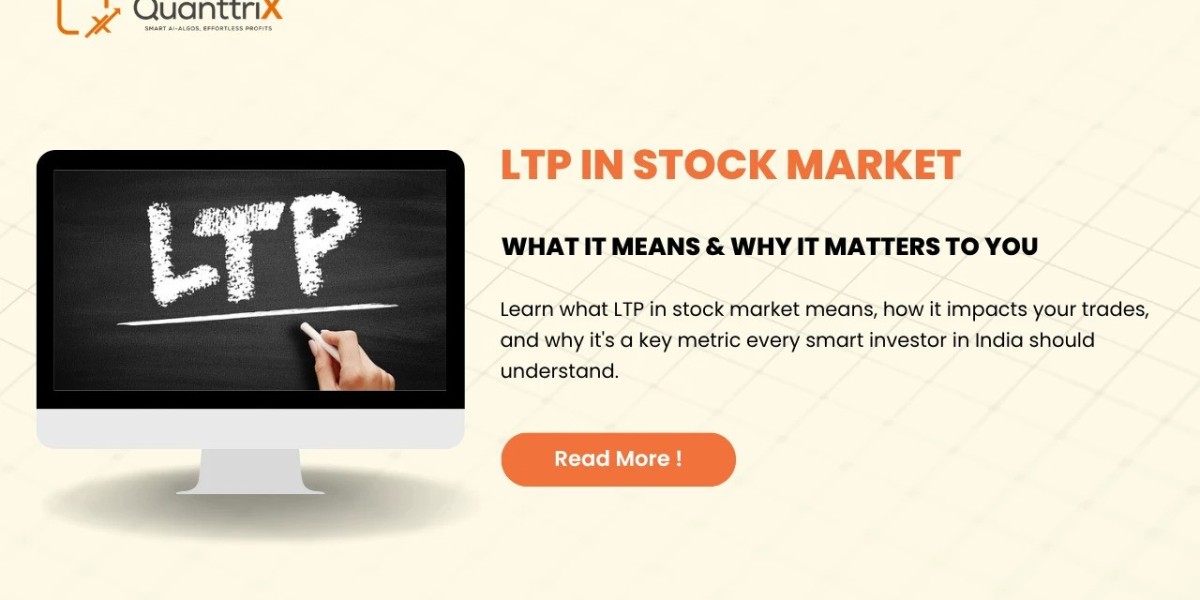LTP in Stock Market: Your Guide to Real-Time Trading, Understanding LTP Full Form, and Exploring Auto Trading Software
Introduction
Have you ever stared at your trading app and wondered, “What does LTP mean in the stock market? Why does it keep changing?” If you’ve asked yourself these questions, you’re not alone! LTP, or the Last Traded Price, is the heartbeat of every stock market transaction—and knowing what it means can make your trading journey much smoother. Whether you’re a seasoned investor, a curious beginner, or someone who’s just heard about auto trading software, this guide will untangle all the mysteries.
Discover LTP in stock market, understand LTP full form in stock market, and explore auto trading software. Learn real-time trading concepts in simple terms!
What is LTP in Stock Market?
LTP in stock market stands for Last Traded Price. In simple terms, LTP is the price at which the most recent purchase or sale of a stock took place. It’s a real-time reflection of what buyers and sellers agreed upon at that exact moment. Imagine it as the scoreboard updating every second during a cricket match—the LTP is constantly refreshed with every trade.
Understanding LTP Full Form in Stock Market
You’ll often see the term LTP full form in stock market in various guides and trading platforms. The full form, Last Traded Price, is exactly what it sounds like: the value of a share at the last completed transaction. Unlike average prices or estimated values, the LTP reports what actually happened—informing you what someone paid to buy or sell the stock at the most recent deal.
How is LTP Calculated?
LTP isn’t calculated using a complicated formula; it’s determined when the highest price a buyer is willing to pay matches the lowest price a seller is willing to accept. Once a trade happens, that price becomes the new LTP. If five people buy at ₹200, ₹202, ₹205, ₹210, and ₹208 in sequence, the LTP after each transaction updates to reflect the most recent deal.
LTP vs. Other Stock Prices (CMP, Closing Price, ATP)
LTP vs. CMP (Current Market Price)
Many investors use LTP and CMP interchangeably. However, CMP refers to the current market quote for a stock, which can sometimes differ from the LTP, especially in fast-moving markets.
LTP vs. Closing Price
The Closing Price is the weighted average of the prices for the last few minutes of the trading session. The LTP is simply the final price at which the last trade was executed.
LTP vs. ATP (Average Traded Price)
ATP averages all trades throughout a period. The LTP is just the most recent deal, not an average or estimate.
Why is LTP Important for Traders?
- Real-Time Indicator: LTP tells traders what’s happening right now—the very last price agreed upon between a buyer and seller.
- Helps in Decision-Making: If you see an LTP much higher than your intended buy, you might wait—or if you’re selling, you might act quickly.
- Supports Technical Analysis: Many trading strategies and technical indicators rely on the LTP for chart pattern analysis and algorithmic trading setups.
- Order Execution: Most “market orders” (buy/sell at the best price available) are executed at or near the LTP, making it pivotal for anyone wanting swift trade completion.
The LTP Analogy: The Price Tag at the Marketplace
Think of the stock market like an energetic street market. Vendors shout prices, buyers shout offers, and the deal happens at a price they both agree on. The LTP is like the price sticker that changes every time someone buys a vegetable at the agreed rate—reflecting the freshest transaction. Just as other buyers watch these deals to gauge if they’re getting a hot deal or overpaying, traders watch LTP for clues about the stock’s value.
Factors Influencing LTP in the Stock Market
- Demand and Supply: If more buyers want a stock (high demand), the LTP tends to go up; more sellers (excess supply) can pull it down.
- Market Sentiment: Good news or positive reports about a company often push LTP higher, while negative news can cause it to fall.
- Trading Volume: Large volumes can quickly swing the LTP. Conversely, with few trades, even a single purchase can noticeably affect the price.
- Order Types: Market orders and limit orders can both affect the LTP, depending on how urgently buyers or sellers want to complete their trades.
LTP and Trading Volume
Trading volume—the total number of shares traded—matters because it shows how “active” a market is. High volume means there are lots of buyers and sellers, making it harder for one trade to move the LTP dramatically. Low volume stocks can see the LTP jump wildly with even a small deal, so be cautious.
How Does LTP Affect Buying and Selling Decisions?
If you plan to buy and notice the LTP rising with each new trade, it might indicate increasing demand—and encourage a speedy decision. Likewise, if the LTP drops, it could signal more sellers or an upcoming dip. Many traders use LTP:
- To time their market entry and exit.
- As a reference for setting stop-loss orders or target profits.
- To gauge momentum, especially in fast-moving stocks.
LTP in Intraday Trading
Intraday traders—those who buy and sell stocks within the same trading session—depend heavily on LTP. Since prices can fluctuate wildly minute by minute, the LTP serves as a real-time compass, helping them make split-second decisions for profit.
Common Mistakes When Interpreting LTP
- Assuming Trends from Just LTP: LTP shows the most recent transaction, but not the overall market mood. Always confirm with trading volumes and trends.
- Ignoring Volatility: High LTP swings are common in illiquid stocks. Don’t mistake a random spike for a genuine trend.
- Overlooking Other Metrics: ATP, volume, and order book data provide a clearer market picture when combined with LTP insights.
Understanding Auto Trading Software
Auto trading software (also called algorithmic or algo trading platforms) automates trading by following a set of rules, signals, or market indicators. Instead of making every trade by hand, you can let the software handle buying and selling for you—sometimes even while you sleep.
How Do Auto Trading Software Use LTP?
Most auto trading tools use LTP as a core input. For example, if your algorithm says, “Buy stock X if its LTP crosses ₹1,000,” the software keeps watching LTP and acts the moment the rule matches. It’s like having a personal assistant who never blinks!
- Triggering Trades: Executing buy/sell orders when LTP hits a certain mark.
- Implementing Stop-Loss or Target Orders: Auto systems use LTP for protecting profits and limiting losses.
- Price Alerts and Notifications: Automated trading can send you alerts or automatically place orders based on real-time changes in LTP.
Top Auto Trading Software Platforms
Here are some leading platforms for auto trading, each leveraging LTP data for order execution and risk management:
Software | Key Features |
AlgoTest | Drag-and-drop strategy builder, backtesting, paper trading simulation |
Zerodha Streak | Visual strategy design, integrates with India’s top brokers |
Tradetron | No-code algo creation, supports multiple assets, cloud-based |
SpeedBot | 100% automation, TradingView integration, no-code, real-time risk management |
MetaTrader (MT4/5) | Advanced algorithmic trading, supports custom scripts, compatible with global brokers |
Robotrader | Fully automated, web-based and desktop software for stocks and commodities |
Each platform uses LTP as a trigger or reference point for executing trades, making it integral to both manual and algorithmic trading.
LTP: Manual vs. Automated Trading
Manual Trading
- You watch the LTP, react, and place trades one at a time.
- Better for hands-on investors or those trading small volumes.
Auto Trading
- Software monitors the LTP and acts instantly when conditions are met.
- Ideal for high-frequency, speed-sensitive, or rule-based strategies.
- Reduces emotions and errors often caused by manual trading.
Which should you choose? If you like control and love analyzing patterns, manual trading works. If you prefer speed, consistency, and scaling your trades without constant supervision, auto trading might be your best friend.
Conclusion
LTP in stock market is far more than a passing number on your screen—it’s a reflection of ongoing demand, supply, and sentiment in real time. Whether you’re checking the LTP to decide your next move, learning its role in technical analysis, or setting up your first auto trading software, understanding LTP empowers you to make better decisions and trade smarter. Remember, every big trading opportunity starts with observing the little numbers—just like watching the changing price tags at your favorite bazaar. So, next time you log into your trading app, let LTP be your trusty guide!
Frequently Asked Questions (FAQs)
- What is the LTP full form in stock market?
LTP stands for “Last Traded Price.” It’s the latest value at which a stock, asset, or security was bought or sold in the market, recorded with each completed transaction.
- Why does the LTP change so frequently?
Because every time a trade happens—whether it's a buy or a sell order—the LTP updates to reflect the most recent price. Fast-moving stocks can see the LTP change multiple times per second.
- How is LTP different from the closing price?
LTP is the last traded price at any moment, constantly updated during market hours. The closing price is the weighted average of prices in the final minutes of trading, serving as an end-of-day benchmark.
- Can I use auto trading software to buy based on LTP?
Absolutely! Many auto trading platforms let you set rules using the LTP. For instance, you can program them to automatically buy or sell if the LTP reaches your desired level.
- Does a high LTP mean the stock is a good buy?
Not necessarily. LTP reflects only the last price paid, not the broader trends or company fundamentals. Always combine LTP with volume, news, and analysis before deciding to invest













